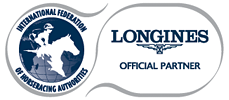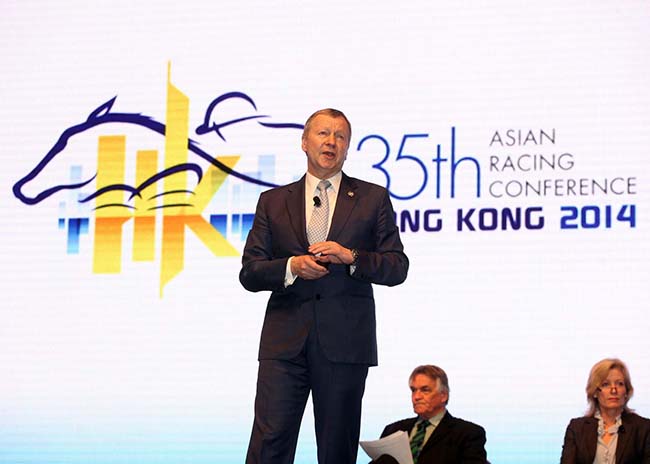Hong Kong Jockey Club CEO chairs presentation on wagering as racing’s lifeblood at opening session of the 35th Asian Racing Conference
06/05/2014
Winfried Engelbrecht-Bresges, the Chief Executive Officer of the Hong Kong Jockey Club, opened the 35th Asian Racing Conference at the Hong Kong Convention and Exhibition Centre this morning (6 May) with a keynote presentation for the session titled ‘Racing’s Lifeblood – the future landscape for wagering’.
-
Winfried Engelbrecht-Bresges, Vice Chairman of the Asian Racing Federation and Chief Executive Officer of the Hong Kong Jockey Club, speaks at the conference’s first plenary session, “Racing’s lifeblood – the future landscape for wagering” today.
As chair of the three-day convocation’s first session, Mr Engelbrecht-Bresges, who is also Vice Chairman of both the Asian Racing Federation (ARF) and the International Federation of Horseracing Authorities (IFHA), pointed out the differences between horseracing and other major sports, which gain their revenues from sponsorship, merchandising, broadcast rights and event-day contributions. He stated that racing brings in only about 15% of its revenue from those streams enjoyed by other sports, while on average 65% of racing’s revenue comes from wagering.
Mr Engelbrecht-Bresges told delegates: “Wagering revenue is the lifeblood of racing. If we want to have a sustainable business model, if we want to make sure our sport is competitive, we have to grow our wagering income.”
He said: “We have to invest heavily in racecourse facilities to meet customer demands; we have to invest in customer services, in marketing programmes and technology in light of the significant increased competition we face. We have to realise we are not only competing in a wagering market, in the end we are in the entertainment market.
“We are competing for the attention, time and entertainment dollar of our current and future customers,” he said, before observing that “racing is losing market share in the global gaming market and as a result becoming less relevant not only to customers but to independently run wagering operators.”
With race betting set to remain flat through to 2017 and sports betting turnover set to exceed that of horseracing for the first time this year, Mr Engelbrecht-Bresges forwarded two major factors “critical” to the development of the racing industry: “regulatory environment and governance” and “value creation”.
“Racing providers have to be aware that we have to conduct our sport on the basis of fair competition and integrity,” he said. “We have to ensure that issues like animal welfare and substance-free racing, not only regionally but on a global basis, have to be addressed and that we don’t have any fundamental issues with what I would like to call the hygiene factors. It’s an absolute must for customer confidence and for acceptance of our sport, especially among the younger customers. Furthermore for stakeholders, like sponsors and governments, they don’t want to see these issues.”
He outlined three main areas for the sport’s organisers to address: “We have to create an attractive value proposition, for people and owners to invest in the sport,” he said “Then we have to provide world-class racing sport entertainment, which is an essential value proposition if we are to grow the interest in the sport; to grow the customer base, especially among those who have a wagering propensity. Thirdly we have to design the racing product in relation to the fixtures, race programme, field size, quality of the sport and fairness of the competition to maximize the wagering potential.”
Mr Engelbrecht-Bresges also reminded delegates that IP (intellectual property) and copyrights must be protected as “the content we create and produce is our major asset.”
He also shared the HKJC’s vertically integrated model, which controls all aspects of the industry, and eventually enabled the Club to initiate changes to revitalise racing and to create relevance to customers, which as a result created a significant increase in income. He said that in-depth customer analysis had identified eight different customer segments, and, after looking at customer behaviour holistically, the Club is tailoring the racing experience to those groups.
“We know that our customer base is not monolithic and that we have different customer segments who have different needs and who process information differently,” said Mr Englebrecht-Bresges. “We need a more outside in look than an inside out look.”
In the face of outside competition, particularly from illegal market and casinos, Mr Engelbrecht-Bresged noted that between 2006 and 2009 the Hong Kong Jockey Club launched a rebate scheme for bigger bets, to address the challenge from the illegal and offshore operators in terms of pricing. And in 2009/10, he told delegates, “we increased our supply by increasing our racedays from 78 to 83, which produced an increase in turnover of 13%.”
In the last four years, said Mr Engelbrecht-Bresges, thanks to the HK$3.5 billion invested since 2009 in the Racecourse Master Plan, a far-reaching redevelopment of racecourse facilities, the implementation of a customer segmentation programme and the engagement with integrated new technology for greater customer connectivity and participation, turnover has increased by 41%.
“Without the vertical integration, the task becomes difficult,” he acknowledged. “In those environments where there is no vertical integration, I would strongly recommend a different approach to connect and collaborate between racing and wagering operators to achieve similar results. The connectivity should provide the synergy in customer analytics and data sharing, to gain a deep understanding of the wagering needs of customers to create an optimal racing product ranging from field size, quality and competitiveness of the racing product itself and racing integrity.”
Jennifer Owen, an independent consultant to the gambling industry who has researched and analysed the gaming market since 1996, delivered the findings of her landmark study titled ‘The Future Landscape for Wagering: Market Analysis and Implications’.
Ms Owen noted: “In many markets to date, and increasingly into the future, racing has become disconnected from wagering. Racing is a price-taker for its product but has lost control of the distribution.”
She suggested that a direct financial linkage needs to be built between racing and betting in every market to incentivise innovation and growth, regardless of the ownership model.
In emphasising the need for racing to engage a younger and wider customer base, Ms Owen also drew attention to various current trends attendant to horserace gaming within the six major jurisdictions (Japan, Hong Kong, USA, UK, Australia and France), one being the notable need to innovate in the face of technological advancements. The rise in the use of mobile devices for placing bets was forwarded as one significant trend.
“Digital is the new shop front,” she said.
Breon Corcoran, Betfair CEO, highlighted the significant journey of growth that his company has been on since facilitating the first wagers between customers in 2000. One of the recent international highlights has been the purchase of TVG in America, which broadcasts high definition racing coverage into 30 million homes across the country. Under Betfair’s ownership, TVG has now become the leading online betting operator in the USA and has also recently concluded a commingling deal with the HKJC, allowing American customers to bet into the Hong Kong pools and watch Hong Kong racing.
Paul Bittar, CEO of the British Horseracing Authority highlighted the significant challenges faced by a racing jurisdiction that has the most heavily deregulated betting industry in the world, combined with an industry that, compared with the Hong Kong model, is “non-vertically integrated”. He said that this means that the BHA has a tough job to ensure that those who provide the racing product get a fair return for their contribution. On a more optimistic note, Mr Bittar mentioned that there is now a realistic prospect in the UK of a genuine commercial replacement to the Levy system of funding, which has changed very little since the 1960s. “We are looking to get into a position in which the government has no direct involvement in the funding of racing.
Phillipe Germond, Chairman and CEO of France’s PMU highlighted how his organisation has reacted to the changing wagering market in France, and particularly to its loss of the monopoly on online betting in the country. The PMU has taken this as an opportunity and is now the second largest online sports bookmaker in France, and third for online poker. “This has given us the opportunity to cross-sell racing to these new sports and poker customers,” said Mr Germond. The PMU has also sought to increase international partnerships, in terms of both import and export of picture rights and associated benefits for turnover. There is a challenging economic situation in France and for the PMU this means a requirement to invest significantly in its business and to be extremely customer-centric. Germonde said: “We either innovate or face continual decline.”
David Attenborough, the head of Tabcorp in Australia discussed the challenges that legal onshore corporate bookmakers are posing to the business, as taxation legislation gives them the chance to offer tote products at a much lower margin than Tabcorp. Tabcorp currently returns 8.9% of its turnover on racing back to the sport – for the bookmakers that figure drops to 1.8%, giving the latter a big advantage. Mr Attenborough told the delegates that Tabcorp is now investing heavily in three key areas, which he categorised as: Customer; Channel; and Product.
| 



